The Newfoundland, also known as the “Newfie or Newf,” is a giant breed dog with big paws, a big heart, a lot of dog hair and a side of dog slobber!
If you’re looking for more information, facts and pictures on this amazing big dog, keep reading to find out what you can expect from those being owned and loved by these amazing gentle giants!
The Newfoundland is a strong, strikingly beautiful dog originating from the Canadian island of, you guessed it, Newfoundland.
The Newfie is a large and impressive breed that is known for its loyalty, strength, and gentle disposition.

Originally bred as working dogs in Newfoundland, Canada, they are renowned for their ability to excel in water rescue and are often referred to as “lifeguard dogs”.
Newfoundlands are also known for their massive size, with males weighing up to 150 pounds and standing over two feet tall at the shoulder.
In addition to their impressive physical stature, they are also known for their thick and luxurious coat, which helps them to stay warm in cold water.
With their friendly and affectionate personalities, Newfoundlands make great family pets and are beloved by many around the world.
This dog breed is big, powerful, and its bear-like appearance can be intimidating to those who are not familiar with this breed, but don’t be scared, behind all that massiveness is one of the most loving and devoted breeds to ever walk the earth.
The Newfoundland, often called the “Newfie” for short because no one can agree on how to pronounce the longer version of the name, these huge dogs are popular as both loving family companions and hard-working dogs.
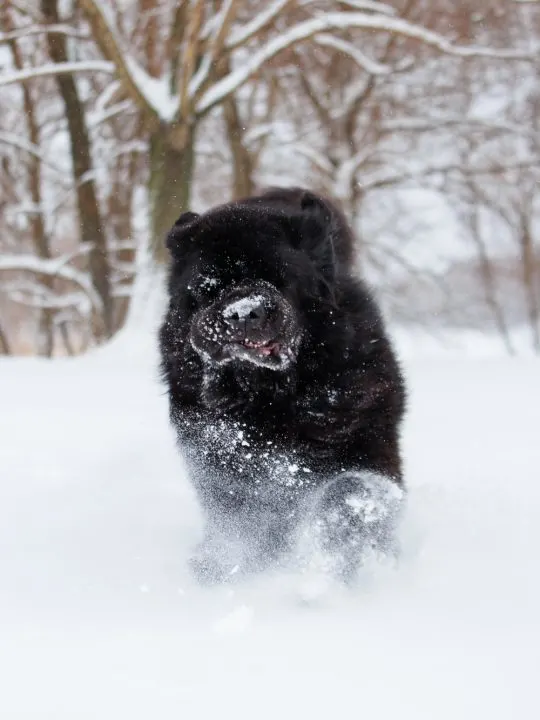
Yep, the Newfie is an ideal working dog and they are happiest when they are working alongside their owners.
Newfies are known as water dogs and they are some of the strongest dogs you’ll ever see in the water.
They even have their own unique swimming style!
Besides loving to swim Newfoundlands are also known for hauling carts their sweet temperament also makes them a great choice for families with children as long as both the child and the dog are trained properly.
I’ve had the pleasure of being owned by Newfies for over 20 years and currently have 2 of them sitting right by my side as I type this!
If you’re interested in learning more about my favorite breed in the world, read on to find out where they come from, how they look and act, their daily needs, training and health issues plus much more!
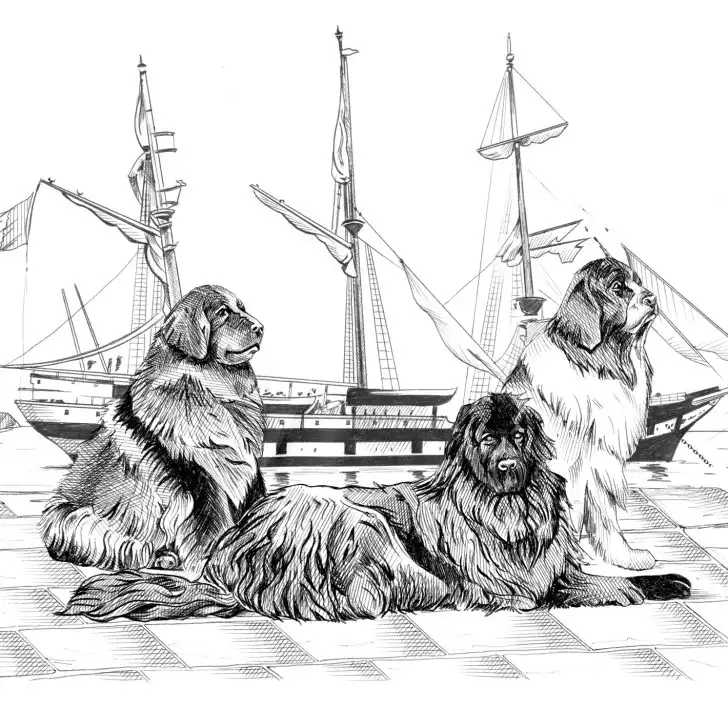
Newfoundland Dog History
The history of the Newfoundland dog is a little unclear but we do know that they likely originated in Newfoundland, Canada in the late 1700s to early 1800s.
In Canada, Newfies were used as working dogs along the coast of Newfoundland.
They would help fishermen haul heavy loads from their ships to land with carts.
It’s said that Newfies most likely were brought from England to Canada on large ships as early as the 1730s
Famous Newfoundlands
As far as famous Newfies go, one of the best-known Newfoundlands is Boatswain.
He was the cherished canine companion of the British poet, Lord Byron.
The poem Epitaph to a Dog was written in Boatswain’s memory, inscribed upon his tomb at Byron’s ancestral estate, Newstead Abbey.
Another famous Newfoundland you’ll read about in the history books is Seaman.
In 1802, when Lewis and Clark began their historic 8,000-mile trek across the American continent, a black Newfoundland named Seaman was part of the expedition.

Today, Seaman is depicted in 10 different Lewis and Clark monuments across the country.
There are also a number of stories of Newfies rescuing drowning fishermen and boat passengers from the sea.
Origin
It’s not 100% clear which dog breeds developed the Newfoundland, with many different theories as to their lineage.
Some say that the Newfoundland dog’s ancestor is the Scandinavian bear dog.
When the Vikings visited Newfoundland more than 1,000 years ago, they may have brought the Scandinavian bear dog with them.
Another theory says that both the Newfoundland dog and the Scandinavian bear dog descend from the Tibetan mastiff.
The Tibetan mastiff’s appearance is very similar to that of the Newfoundland dog.
And still, some think that Newfies came from native dogs who were then mixed with Great Pyrenees dogs.
According to a study done on the Newfoundland’s DNA, these dogs are close relatives of other Canadian retrievers such as Golden Retrievers, Nova Scotia Duck Tolling Retrievers, and Labrador Retrievers.
These dogs have had many different jobs over the last few hundred years.
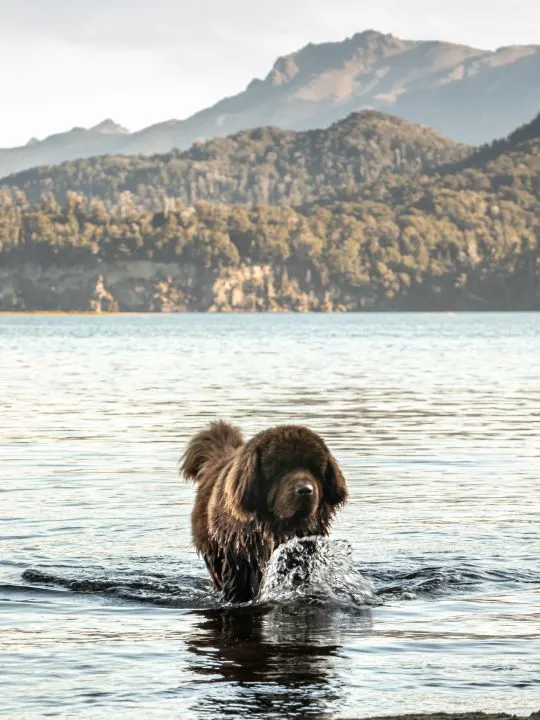
While they were known to help pull carts in port areas, they were also brought on fishing boats to help haul nets, cargo and even people.
Their strong body, strength and unique swimming style allowed them to retrieve objects that had fallen overboard, as well as rescue drowning people even in rough seas.
Yes, Newfies even have their very own unique swimming style which is more like a breaststroke than a doggy paddle!
Pretty cool, eh?!
Almost Extinct
The Newfoundland was almost extinct which is crazy when you think about it!
Richard Edwards, the Commodore-Governor of Newfoundland, decreed in 1780 that each household was legally permitted to own only one Newfoundland dog.
He did this to promote sheep raising but the law failed to accomplish this.
Instead, for many years, the population of the Newfoundland dog declined.
As a result, only a few were left on the island.
Thankfully, fanciers of the breed helped to bring the Newfie population back to life again.
Exportation allowed the Newfie to achieve popularity in other parts of the world, especially in England and other parts of Europe.
In 1886, the American Kennel Club recognized the Newfoundland and they became the 32nd breed to join the club.
Today, the Newfoundland is a popular breed all over the world.
As of 2020, the Newfie is the 41st most popular dog according to the AKC.
Newfie Temperament
Most Newfies love to work when they are given the chance!
They work best alongside their owner and they love to learn new things.
Newfies are always wanting to please their owners so they are obedient, intelligent and quick learners.
Despite their bear-like appearance and hearty work ethic, Newfies are mostly known for being gentle giants and very loving.
The AKC states that the Newfoundlands sweet disposition is “the most important single characteristic of the breed.”
The Newfie is also often referred to as a “nanny dog” because they are so patient and gentle with children.
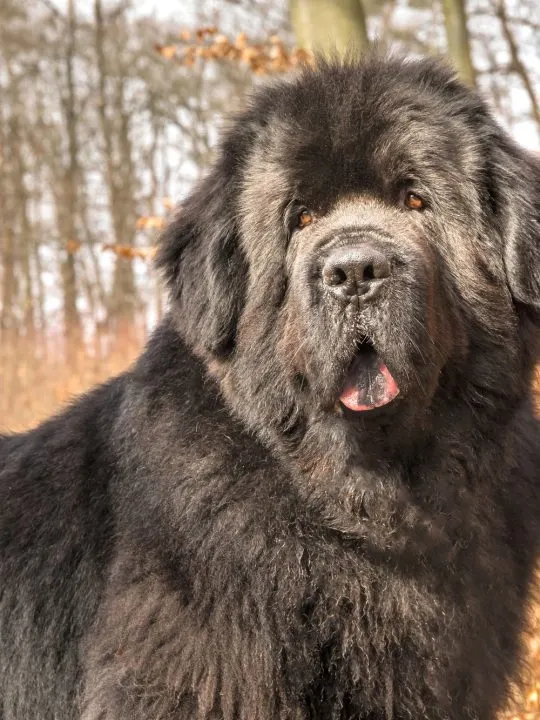
However, this applies to adult Newfies that have been trained.
A Newfoundland puppy is nippy, have bursts of energy and can be rough with young children at times.
It’s important to always monitor your Newfie and child when they are together.
While Newfies aren’t considered guard dogs, they are protectors of their families.
They don’t care about someone coming in to steal your TV but they do care if their family is in harm’s way.
Newfies aren’t normally aggressive but they will put themselves between their family and a perceived threat.
Newfies are actually considered wonderful therapy or service dogs because they have an incredible sense of duty, gentle temperament, keen senses, and strong protective instincts.
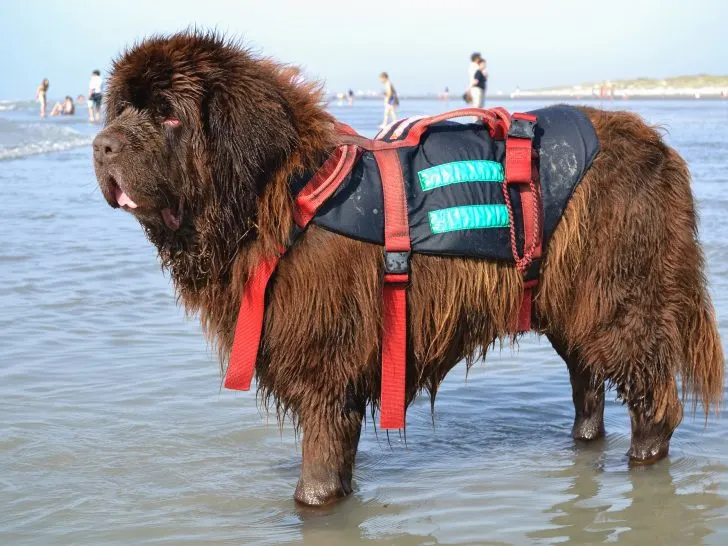
Size and Appearance
The Newfoundland is known as a giant breed and they are a powerhouse of a dog.
They are large-boned and powerful no matter male or female.
On average, male Newfies are 28 inches at the withers, while females average a little smaller at around 26 inches.
Male Newfoundlands weigh anywhere roughly 130 to 150 pounds and females weigh on average 100 to 120 pounds.
The biggest Newfoundland on record is 36″ tall at the withers and weighs 180 pounds.
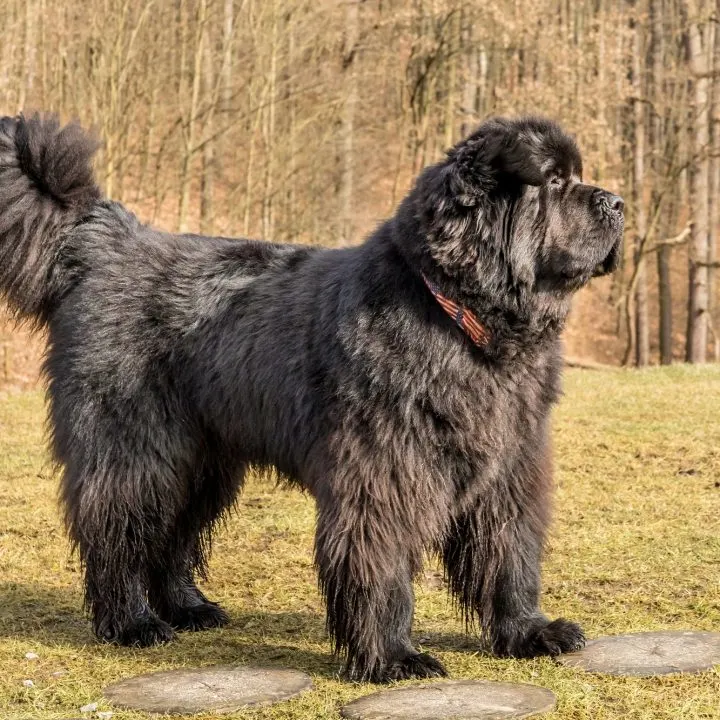
A Newfie should be a well-balanced dog that is deep-bodied, heavily boned, muscular, and be strong with powerful hindquarters.
They should not be obese and lazy.
Newfies are longer than they are tall and they have massive heads, pronounced jowls broad muzzles.
They should have a gentle expression when you look at them because their sweet temperament is their best quality.
Most Newfies will have black noses but brown Newfies will have dark brown noses.
They have dark brown eyes.
Newfies also have webbed feet and a large lung capacity which is why they are such strong swimmers!
Their tails are wide and fluffy at the base.
Size should never be desired over health.
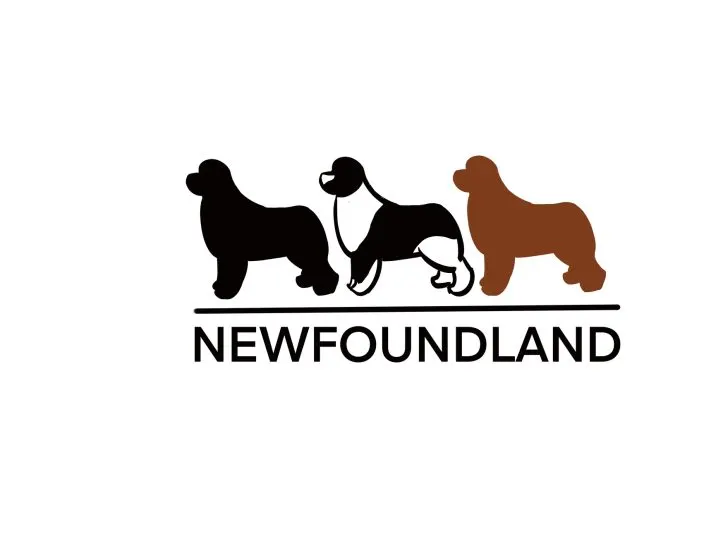
Newfoundland Coat and Colors
Newfoundlands have one of the coolest double coats around!
Their thick double coat consists of two layers: a dense undercoat that keeps them warm in the winter and a water-resistant top layer that consists of guard hairs that protect them in the cold water or chilly weather.
Their oily outer coat can be straight or a little wavy across their body.
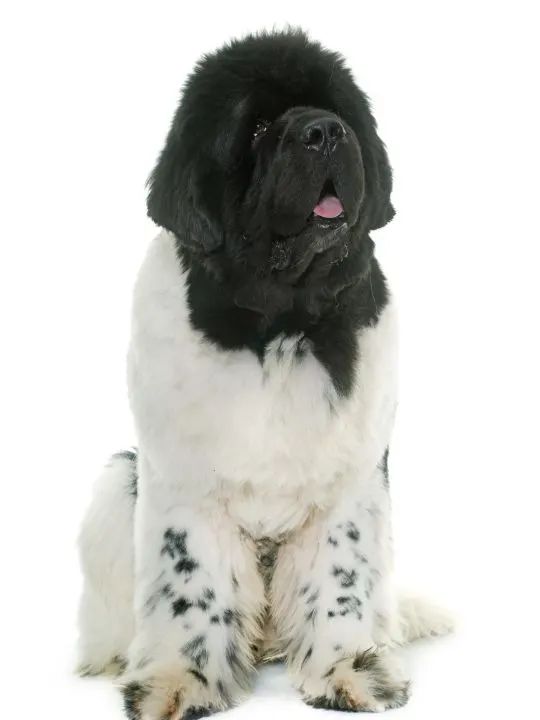
While the black Newfoundland is the most common in terms of color, the AKC also recognizes Newfoundland colors in, brown, grey and Landseer (white dog with black markings) Newfoundlands.
In Canada, recognized colors are black and Landseer Newfoundlands.
Exercise Requirements
Most people view Newfies are lazy couch potatoes who sleep a lot but in fact, they are quite the opposite especially when they are younger than 2 years of age.
Just like any breed of dog, Newfies require exercises such as daily walks or swimming but some also enjoy doing things such as dock diving or even nose work.
Newfie puppies are giant furballs of energy but since they should avoid a lot of strenuous exercises until their growth plates close around 2 years of age, they should avoid things such as running on hard surfaces, walking long distances and pulling carts.
Newfie puppies do best with a few minutes of moderate exercise a few times a day.
Swimming is always a good choice for Newfies of any age, puppies and seniors but keep in mind that not all Newfoundlands will love the water.
Living Requirements
Since Newfies are always happiest when they are by their owner’s side, the size of the house or apartment you live in doesn’t matter much to them.
Just make sure there’s room on the couch for them!
Most breeders and rescue groups will require that Newfies have a fenced-in moderate to large yard where they can lounge and roan safely.
As far as weather is concerned, since Newfies are a colder breed of dog, they love colder climates.
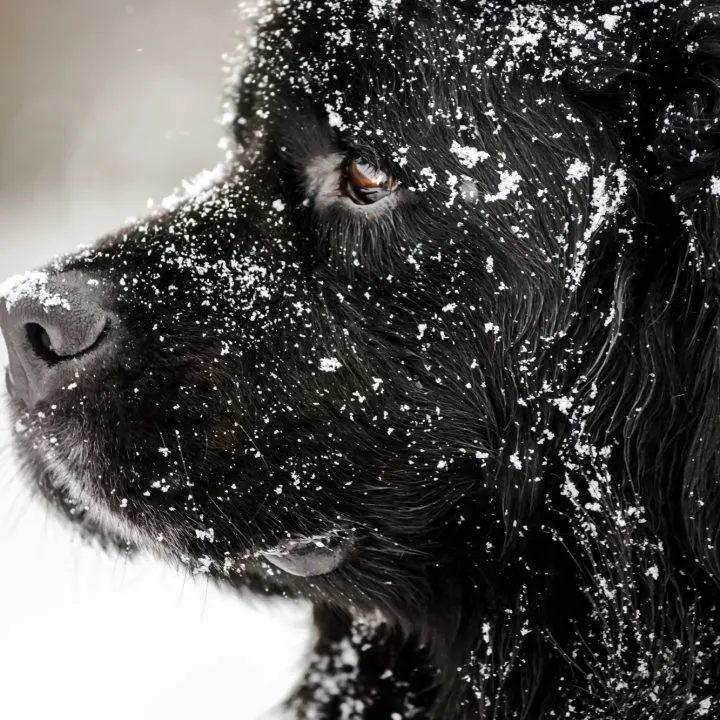
This isn’t to say that they can’t tolerate warmer weather but if they could choose between sun and snow most would definitely pick a pile of snow to sleep in!
Newfies are prone to overheating so it’s important to know the signs of heatstroke and since it’s almost impossible to get Newfies to come inside during the winter, it’s a good idea to know how much cold they can tolerate also.
Another important thing to think about is caring for a senior Newfie.
Newfies will often have mobility issues as they get older so it’s important to have a plan in place when that day comes.
A lifting harness is a great accessory for older Newfies and so are dog ramps or dog steps for getting in and out of the car.
Newfoundland Training
A Newfoundland is easy to train for the experienced owner.
They are intelligent dogs with a strong desire to please.
With that being said, training should start when they are puppies and continue well into their adult life.
Newfies train best in short training sessions as they get bored and distracted easily.
Newfoundlands can be a sensitive breed so harsh training techniques are discouraged and positive reinforcement is better received.
Leash training is important and should be started as soon as possible.
Other common behavior issues can be jumping, counter surfing, puppy nipping and resource guarding.
Socializing a Newfie is also important because you can’t get very far walking a Newfie without someone stopping you to ask questions or take pictures!
Newfies get along with most other pets but some can have a prey drive so it’s important to monitor them with first-time encounters of things such as chickens and bunnies.
Since Newfies are so dedicated to their families, many can have separation anxiety so it’s important that they don’t spend too much time alone on a consistent basis because they may become destructive.
Health
Newfoundlands are a strong breed but just like most big dogs, they do come with their share of health problems.
The average lifespan of a Newfie used to be 8-10 years but many Newfies live well into their teens with proper care and a quality diet.
You can have a Newfoundland that will never have any health issues or you could have a Newfie that is a medical disaster which is why it’s important to stay clear of backyard breeders and instead take your time to search for a reputable Newfoundland dog breeder.
Skin Issues
Newfoundland dogs are notorious for getting skin infections due to improper grooming or allergies
These allergies can be due to food, environmental or seasonal reactions and often be severe leading to high veterinarian bills.
They can also make a Newfie smell pretty bad.
Heart Problems
DCM or dilated cardiomyopathy is a disease of the heart muscle that results in weakened contractions and poor pumping ability.
As the disease progresses the heart chambers become enlarged, one or more valves may leak, and signs of congestive heart failure develop.
In Newfoundlands, this may be caused by a lack of taurine in their diet or it could be genetic.
Subvalvular aortic stenosis also referred to as subaortic stenosis or SAS, is a common heart defect in dogs, especially Newfoundlands.
In dogs with SAS, there is added tissue below the aortic valve.
This abnormal tissue creates an obstruction that the heart has to overcome to pump blood to the body.
This stenosis makes the heart work harder than normal.
A heart murmur is created by blood being pumped across the stenosis into the aorta.
Hip Dysplasia
Hip dysplasia is a congenital disease that affects the hip joints.
The joints become loose and begin to rub on the hip socket causing the socket to lose its shape.
This condition leads to a form of arthritis called degenerative joint disease.
Be sure to ask your breeder if your Newfie pup has been screened for this condition.
Dog Bloat/Gastric Torsion
Bloat or gastric torsion is an emergency medical condition that affects deep-chested breeds such as the Newfoundland.
Gastric torsion happens when the stomach fills with air or gas, and then twists.

X-ray of dog lateral view with Gastric dilatation volvulus “GDV” or stomach twists- Double bubble pattern indicates stomach torsion has occurred-Veterinary medicine and Veterinary anatomy Concept.
All owners of Newfies should be aware of this condition because it is very dangerous and could be fatal if immediate medical attention is not sought.
Common signs of dog bloat are distended belly, retching without being able to vomit, restlessness, increased heart rate, and excessive drooling.
Eye Conditions
Newfoundlands are prone to developing eye conditions such as entropion or ectropion.
This is where the lower eyelids turn in or out.
Responsible breeders will check for hereditary eye issues so make sure to ask about that!
Hypothyroidism
Hypothyroidism is a common medical condition in the Newfoundland breed where the dog’s body is deficient in thyroid hormone.
Nutrition
A healthy diet is the most important part of a dog’s health.
Newfies can be fed a dry kibble or a raw diet as long as they are both balanced and nutritious.
Your breeder should be able to help guide on what type of diet is best for your Newfoundland.
Since Newfies are a giant breed you should talk to your breeder about what type of large breed puppy food or all life-stage food they recommend.
I personally fed a large breed puppy food until Lou was 4 months old and then switched to an all-stages food.
Recommended feeding amounts will vary greatly based on what type of food you feed.
Adult Newfies usually consume about 3-5 cups of dry kibble a day.
These meals should be split up into 2 meals a day and Newfie should be encouraged to eat slowly rather than gobbling their food fast to help to prevent gastric torsion.
Since Newfie puppies grow fast it’s important to make sure that they don’t grow too fast which can lead to joint issues later down the road.
It’s also important to keep a Newfie at a healthy weight to avoid problems such as hip dysplasia and shoulder dysplasia.
How much food you should be feeding your Newfie also depends on their activity, health issues and age.
If you’re in doubt, check with your veterinarian or breeder.
An appropriate-sized Newfie will live a longer, happier, and healthier life!
Newfoundland Grooming
Given the Newfie’s double coat, owners of this breed should be prepared for daily brushing during shedding season and weekly when they are not blowing their coats.
Newfies do shed all year round but they blow coat twice a year, during the fall and spring.
Blowing coat is when a dog loses their undercoat to make way for new hair growth.
A Newfie will lose tufts of hair during this time and your house, furniture, clothes and floors will be covered with dog hair!
During heavy shedding season, brushing or line combing should be done every day to help them lose their extra fur more easily.
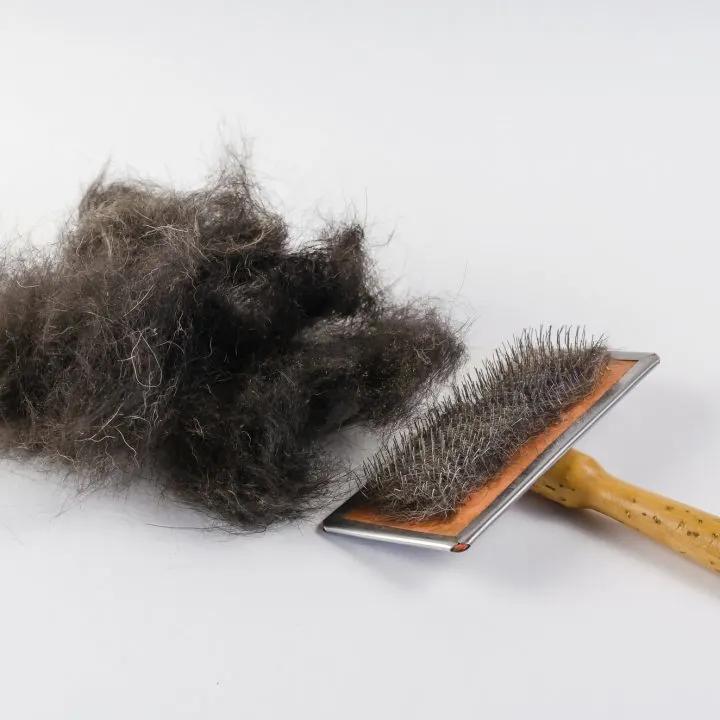
It’s also helpful to use a high-velocity dog dryer to help blast some of the loose hair and dander out.
Bathing the Newfoundland can also be a long process.
A Newfie should get a bath whenever they need one.
The most important thing to do when bathing a Newfie is to thoroughly dry their coat.
Newfies are prone to skin conditions such as hot spots so it’s important to make sure they get dried all the way down to their skin.
Newfies are also prone to ear infections so make sure to regularly check their ear, especially after swimming.
Some Newfie owners groom their Newfies on their own while others will take them to a professional groomer.
Grooming your Newfie by yourself can be intimidating but it’s a great bonding experience and easy to do once you get the hang of it!
Grooming should be introduced to the Newfie as soon as you bring them home.
Get them up on the grooming table and slowly introduce them to all the grooming tools.
If you do opt to take your Newfie to a groomer, always make sure that they are familiar with the Newfie breed!
Breeders and Puppy Costs
If you choose to buy a Newfoundland from a breeder, it’s important that you chose a good breeder that is in it for the love of the breed and not for money.
Newfies can be found in many puppy mills, especially in Ohio, Pennsylvania and Indiana so it’s important to learn how to spot a puppy mill or backyard breeder.
Stay away from breeders that offer “rare” colors or “dry-mouth Newfoundlands“.
Seek out a Newfoundland breeder who breeds for health and temperament oversize.
A responsible breeder will be able to give you guarantees of the puppy’s health, with certificates from the vet proving there are no hereditary problems.
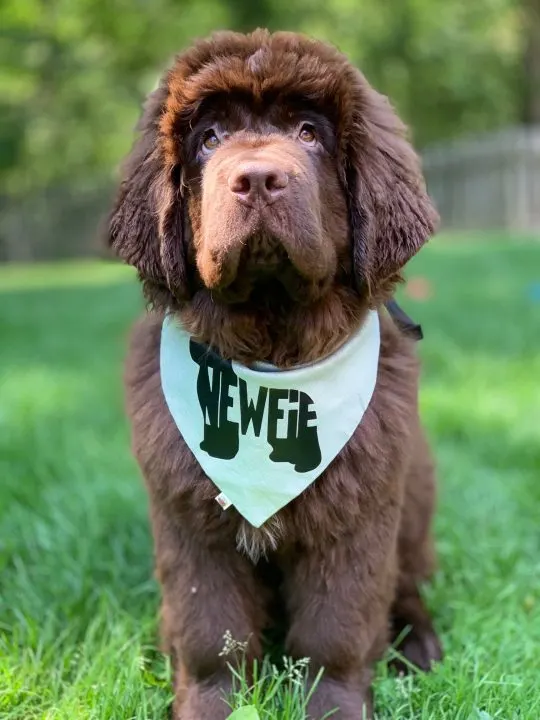
Puppies who are treated like family are almost always the most well-adjusted; look for breeders who have a cozy spot in the home for their pups, as well as encourage interaction with people.
A good place to look for a Newfie breeder is by visiting the Newfoundland Club of America’s Breeders List.
The price of a Newfoundland will range from $1200 to $3000 from a reputable breeder that conducts health checks and screens for hereditary health problems in the breed.
Rescues and Shelters
There are many Newfoundlands in rescues and shelters across the world right now so if you’re open to adopting an adult Newfoundland check your local rescue group.
